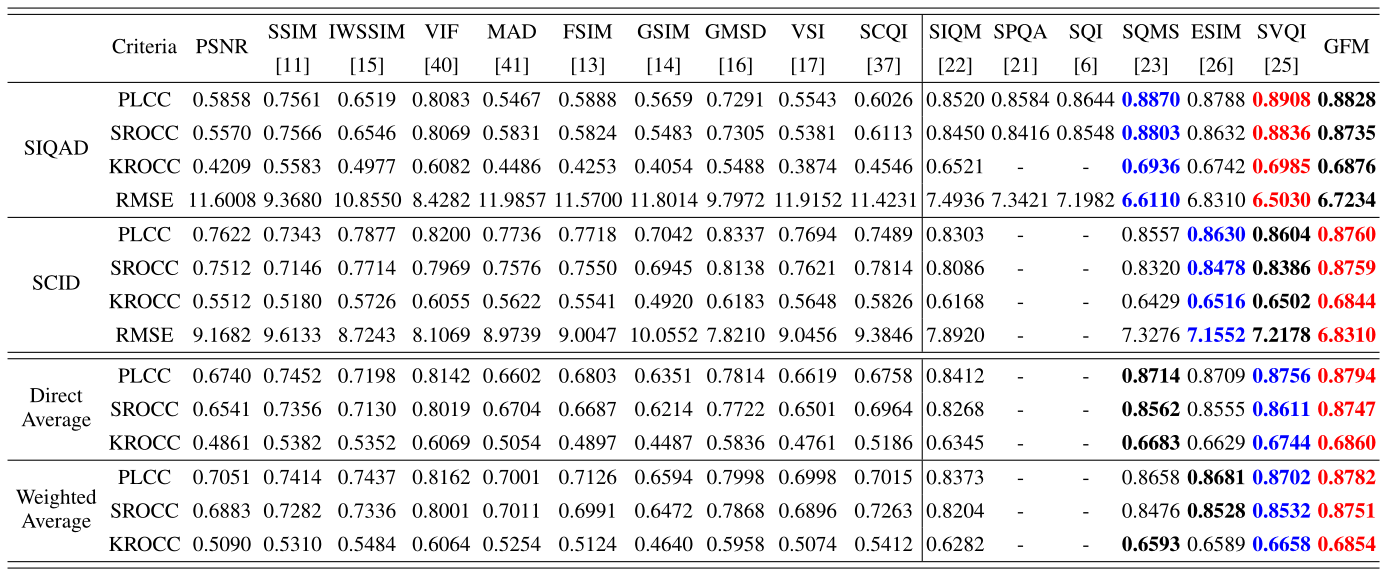| GFM |
Z. Ni, H. Zeng, L. Ma, J. Hou, J. Chen, and K.-K. Ma "A Gabor Feature-based Quality Assessment Model for the Screen Content Images," IEEE Transactions on Image Processing, vol. 27, no. 9, pp. 4516-4528, Sept. 2018. [ Full Text] |
| SSIM |
Z. Wang, A. C. Bovik, H. R. Sheikh, and E. P. Simoncelli, "Image Quality Assessment: From Error Visibility to Structural Similarity," IEEE Transactions on Image Processing, vol. 13, no. 4, pp. 600-612, Apr. 2004. [ Full Text] |
| IWSSIM |
Z. Wang, Q. Li, "Information Content Weighting for Perceptual Image Quality Assessment," IEEE Transactions on Image Processing, vol. 20, no. 5, pp. 1185-1198, Apri. 2011. [ Full Text] |
| VIF |
H. R. Sheikh, A. C. Bovik, "Image Information and Visual Quality," IEEE Transactions on Image Processing, vol. 15, no. 2, pp. 430-444, Feb. 2006. [ Full Text] |
| MAD |
E. C. Larson, D. M. Chandler, "Most Apparent Distortion: Full-Reference Image Quality Assessment and the Role of Strategy," Journal of Electronic Imaging, vol. 19, no. 1, Jan. 2010. [ Full Text] |
| FSIM |
L. Zhang, L. Zhang, X. Mou, and D. Zhang, "FSIM: A Feature Similarity Index for Image Quality Assessment," IEEE Transactions on Image Processing, vol. 20, no. 8, pp. 2378-2386, Aug. 2011. [ Full Text] |
| GSIM |
A. Liu, W. Lin, and M. Narwaria, "Image Quality Assessment Based on Gradient Similarity," IEEE Transactions on Image Processing, vol. 21, no. 4, pp. 1500-1512, Apr. 2012. [ Full Text] |
| GMSD |
W. Xue, L. Zhang, X. Mou, and A. C. Bovik, "Gradient Magnitude Similarity Deviation: A Highly Efficient Perceptual Image Quality Index," IEEE Transactions on Image Processing, vol. 23, no. 2, pp. 684-695, Feb. 2014. [ Full Text] |
| VSI |
L. Zhang, Y. Shen, and H. Li, "VSI: A Visual Saliency-Induced Index for Perceptual Image Quality Assessment," IEEE Transactions on Image Processing, vol. 23, no. 10, pp. 4270-4281, Oct. 2014. [ Full Text] |
| SIQM |
K. Gu, S. Wang, G. Zhai, S. Ma, and W. Lin, "Screen image quality assessment incorporating structural degradation measurement," IEEE International Symposium on Circuits and Systems, pp. 125�C128, May 2015. [ Full Text] |
| SPQA |
H. Yang, Y. Fang, and W. Lin, "Perceptual quality assessment of screen content images," IEEE Transactions on Image Processing, vol. 24, no. 11, pp. 4408�C4421, August 2015. [ Full Text] |
| SQI |
S. Wang, K. Gu, K. Zeng, Z. Wang, and W. Lin, "Objective quality assessment and perceptual compression of screen content images," IEEE Computer Graphics and Applications, vol. 38, no. 1, pp. 47�C58, May 2016. [ Full Text] |
| SQMS |
K. Gu, S. Wang, H. Yang, W. Lin, G. Zhai, X. Yang, and W. Zhang, "Saliency-guided quality assessment of screen content images," IEEE Transactions on Multimedia, vol. 18, no. 6, pp. 1098�C1110, March 2016. [ Full Text] |
| ESIM |
Z. Ni, L. Ma, H. Zeng, J. Chen, C. Cai, and K.-K. Ma, "ESIM: Edge similarity for screen content image quality assessment," IEEE Transactions on Image Processing, vol. 26, no. 10, pp. 4818�C4831, June 2017. [ Full Text] |
| SVQI |
K. Gu, J. Qiao, X. Min, G. Yue, W. Lin, and D. Thalmann, "Evaluating quality of screen content images via structural variation analysis," IEEE Transactions on Visualization and Computer Graphics, November 2017, DOI: 10.1109/TVCG.2017.2771284. [ Full Text] |
| SIQAD |
H. Yang, Y. Fang, and W. Lin, "Perceptual Quality Assessment of Screen Content Images", IEEE Transactions on Image Processing, vol. 24, no. 11, pp. 4408-4421, Aug. 2015. [ Full Text][ Download] |
| SCID |
Z. Ni, L. Ma, H. Zeng, J. Chen, C. Cai, and K.-K. Ma, "ESIM: Edge similarity for screen content image quality assessment," IEEE Transactions on Image Processing, vol. 26, no. 10, pp. 4818�C4831, June 2017. [ Full Text][ Download] |


